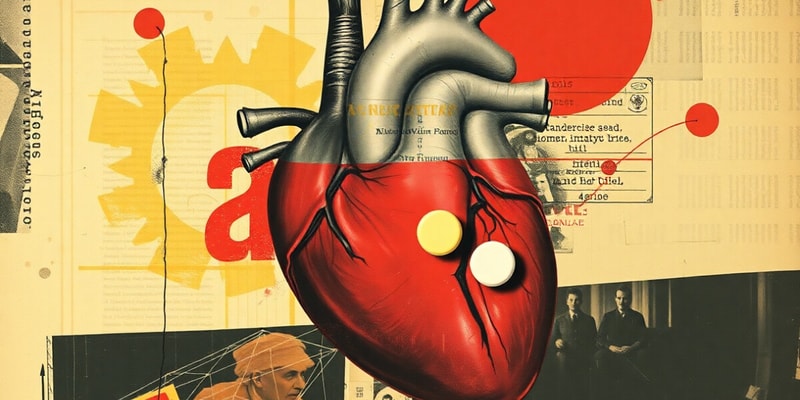Podcast
Questions and Answers
What is the primary indication for nonselective beta blockers like propranolol, labetalol, and carvedilol?
What is the primary indication for nonselective beta blockers like propranolol, labetalol, and carvedilol?
What are the primary receptors blocked by nonselective beta blockers?
What are the primary receptors blocked by nonselective beta blockers?
Which of the following is a common side effect of nonselective beta blockers?
Which of the following is a common side effect of nonselective beta blockers?
What must be monitored when a patient is on nonselective beta blockers?
What must be monitored when a patient is on nonselective beta blockers?
Signup and view all the answers
Which condition is a contraindication for nonselective beta blockers?
Which condition is a contraindication for nonselective beta blockers?
Signup and view all the answers
What should be done if a patient's systolic blood pressure is less than 90 mmHg while on nonselective beta blockers?
What should be done if a patient's systolic blood pressure is less than 90 mmHg while on nonselective beta blockers?
Signup and view all the answers
What distinguishes beta-1 blockers like metoprolol and atenolol from nonselective beta blockers?
What distinguishes beta-1 blockers like metoprolol and atenolol from nonselective beta blockers?
Signup and view all the answers
Which of the following is a primary indication for beta-1 blockers?
Which of the following is a primary indication for beta-1 blockers?
Signup and view all the answers
What is a potential consequence of abruptly stopping beta-1 blockers?
What is a potential consequence of abruptly stopping beta-1 blockers?
Signup and view all the answers
Which side effect is common with both nonselective and beta-1 blockers?
Which side effect is common with both nonselective and beta-1 blockers?
Signup and view all the answers
What is the primary effect of nonselective beta blockers on heart rate?
What is the primary effect of nonselective beta blockers on heart rate?
Signup and view all the answers
Which medication is classified as a nonselective beta blocker?
Which medication is classified as a nonselective beta blocker?
Signup and view all the answers
Which side effect is commonly associated with beta blockers, particularly in patients with asthma?
Which side effect is commonly associated with beta blockers, particularly in patients with asthma?
Signup and view all the answers
What should be monitored in patients taking beta blockers due to their effect on the heart?
What should be monitored in patients taking beta blockers due to their effect on the heart?
Signup and view all the answers
Which of the following is a potential consequence of abruptly stopping a beta blocker?
Which of the following is a potential consequence of abruptly stopping a beta blocker?
Signup and view all the answers
Which action is advisable regarding exercise for patients taking beta blockers?
Which action is advisable regarding exercise for patients taking beta blockers?
Signup and view all the answers
What is one of the therapeutic effects of beta blockers on the heart?
What is one of the therapeutic effects of beta blockers on the heart?
Signup and view all the answers
Which beta blocker is known for its dual action on both alpha and beta receptors?
Which beta blocker is known for its dual action on both alpha and beta receptors?
Signup and view all the answers
What is a common concern when prescribing beta blockers for patients with diabetes?
What is a common concern when prescribing beta blockers for patients with diabetes?
Signup and view all the answers
Which factor is considered when determining the suitability of beta blockers for a patient?
Which factor is considered when determining the suitability of beta blockers for a patient?
Signup and view all the answers
What critical patient education point should be emphasized for individuals taking beta-1 blockers?
What critical patient education point should be emphasized for individuals taking beta-1 blockers?
Signup and view all the answers
What is the primary action of beta blockers on the cardiovascular system?
What is the primary action of beta blockers on the cardiovascular system?
Signup and view all the answers
Which medication should be avoided in patients with asthma due to potential bronchospasm?
Which medication should be avoided in patients with asthma due to potential bronchospasm?
Signup and view all the answers
What should patients be instructed to report while on beta blockers?
What should patients be instructed to report while on beta blockers?
Signup and view all the answers
What condition can result from the abrupt withdrawal of beta blockers?
What condition can result from the abrupt withdrawal of beta blockers?
Signup and view all the answers
What is a potential risk of using beta blockers in diabetic patients?
What is a potential risk of using beta blockers in diabetic patients?
Signup and view all the answers
Which beta blocker is often used for its dual action on alpha and beta receptors?
Which beta blocker is often used for its dual action on alpha and beta receptors?
Signup and view all the answers
What lifestyle change is often recommended for patients taking beta blockers?
What lifestyle change is often recommended for patients taking beta blockers?
Signup and view all the answers
Which of the following should be monitored in patients taking beta blockers?
Which of the following should be monitored in patients taking beta blockers?
Signup and view all the answers
What effect do beta blockers have on the lungs?
What effect do beta blockers have on the lungs?
Signup and view all the answers
Study Notes
Beta Blockers: Study Notes
-
Nonselective Beta Blockers (e.g., propranolol, labetalol, carvedilol):
- Primary indication: Hypertension, angina, arrhythmias, and myocardial infarction (MI).
- Mechanism of action: Block beta-1 and beta-2 receptors.
- Common side effects: Bronchospasm, hypotension, bradycardia.
- Contraindications: Asthma, severe bradycardia, AV block.
- Important monitoring: Blood pressure, heart rate, and respiratory status.
- Important considerations: Sudden discontinuation should be avoided; gradual tapering is necessary. Hold medication if systolic blood pressure drops below 90 mmHg.
-
Beta-1 Blockers (e.g., metoprolol, atenolol):
- Primary indication: Hypertension, angina, arrhythmias, MI, and prevention of future cardiovascular events.
- Mechanism of action: Block beta-1 receptors specifically, primarily in the heart.
- Cardioselectivity: Blocks beta-1 receptors in the heart with less effect on beta-2 receptors in the lungs. This minimizes bronchospasm risk compared to nonselective blockers.
- Important monitoring: Blood pressure, heart rate, and signs of hypoglycemia (especially in diabetic patients).
- Contraindications: Bronchospastic diseases, severe bradycardia, AV block (especially when combined with other medications).
- Important considerations: Sudden discontinuation can cause rebound hypertension. Gradual tapering is critical.
-
General Considerations for Both:
- Hypotension & Bradycardia: Common side effects; monitor closely.
- Bronchospasm (nonselective): Increased risk; these are contraindicated in asthmatics.
- Hypoglycemia Masking: Beta-blockers can mask the signs of hypoglycemia; monitor blood glucose levels closely, especially in diabetic patients.
- Exercise: Monitor exercise tolerance and avoid extreme exertion initially.
- Drug Interactions: Many medications interact with beta-blockers, consult with prescribing physician.
- Abrupt discontinuation: Avoid sudden cessation of therapy; gradual withdrawal is required .
- Important considerations: Avoid grapefruit juice due to potential drug interactions.
-
Specific Indications for Beta-Blockers:
- Hypertension: Lowering blood pressure.
- Angina: Reducing the workload on the heart, preventing angina attacks.
- Arrhythmias: Slowing the heart rate to control irregular heart rhythms.
- Heart failure: Decreasing workload on the heart; used in conjunction with other treatments.
- MI: Used after a heart attack to reduce the risk of further events; in selected patients.
-
Important Points: Avoid abruptly stopping therapy; gradual taper is necessary to avoid rebound hypertension. Regular monitoring of blood pressure and heart rate is crucial for both nonselective and beta-1 selective beta-blockers. Exercise tolerance should be monitored cautiously. Medication adherence is essential to achieve desired therapeutic effects and avoid serious side effects.
Studying That Suits You
Use AI to generate personalized quizzes and flashcards to suit your learning preferences.
Description
This quiz covers essential information about beta blockers, including nonselective and beta-1 selective types. Key aspects include indications, mechanisms of action, side effects, contraindications, and monitoring requirements. Understanding these details is crucial for effective medication management in cardiovascular health.


